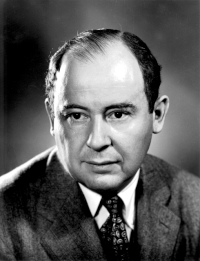
Photo from wikipedia
Since the proposal of monopole Cooper pairing in Ref. [1], considerable research efforts have been dedicated to the study of Cooper pairing order parameters constrained (or obstructed) by the nontrivial… Click to show full abstract
Since the proposal of monopole Cooper pairing in Ref. [1], considerable research efforts have been dedicated to the study of Cooper pairing order parameters constrained (or obstructed) by the nontrivial normal-state band topology at Fermi surfaces in 3D systems. In the current work, we generalize the topologically obstructed pairings between Chern states (like the monopole Cooper pairing) by proposing Euler obstructed Cooper pairing in 3D systems. The Euler obstructed Cooper pairing widely exists between two Fermi surfaces with nontrivial band topology characterized by nonzero Euler numbers; such Fermi surfaces can exist in 3D PT -protected spinless-Dirac/nodal-line semimetals with negligible spin-orbit coupling, where PT is the space-time inversion symmetry. An Euler obstructed pairing channel must have pairing nodes on the pairing-relevant Fermi surfaces, and the total winding number of the pairing nodes is determined by the sum or difference of the Euler numbers on the Fermi surfaces. In particular, we find that when the normal state is time-reversal invariant and the pairing is weak, a sufficiently-dominant Euler obstructed pairing channel with zero total momentum leads to nodal superconductivity. If the Fermi surface splitting is small, the resultant nodal superconductor hosts hinge Majorana zero modes. The possible dominance of the Euler obstructed pairing channel near the superconducting transition and the robustness of the hinge Majorana zero modes against disorder are explicitly demonstrated using effective or tight-binding models. Our work presents the first class of higher-order nodal superconductivity originating from the topologically obstructed Cooper pairing.
Journal Title: Physical Review B
Year Published: 2022
Link to full text (if available)
Share on Social Media: Sign Up to like & get
recommendations!